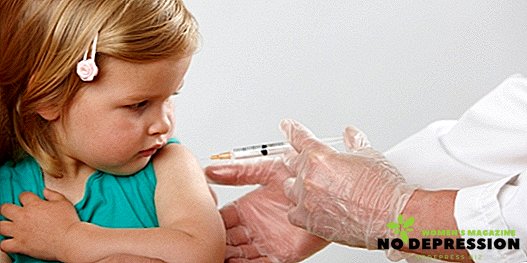Prophylactic vaccinations can avoid many diseases, sometimes quite dangerous. For example, with the help of vaccination, black pox was completely defeated, and the incidence of polio, tetanus and other dangerous infections was significantly reduced.
To make parents more comfortable, vaccinations for small children are scheduled. Vaccines against certain diseases are combined, which makes it possible to take root against several diseases at once for one vaccination.

Parents and the local pediatrician should ensure compliance with the vaccination schedule. It is their close cooperation that will allow the child to grow up healthy.
The value and need for vaccination
The importance of vaccination, both for the individual and for the population as a whole, cannot be overestimated. Thanks to vaccinations, most people do not experience or suffer in mild form whooping cough, measles and diphtheria, which can be fatal, and the more formidable "adult" infections - smallpox, polio, tetanus, plague.
The effectiveness of vaccination is based on the fact that the components of the pathogen or the pathogen itself are introduced into the body in the form in which it cannot cause the disease.
The body's immune system produces antibodies to the pathogen, and when confronted with an unvaccinating ("wild") microorganism, it responds with a complete immune response.
The importance of vaccination for the population is even higher. When conditions are created in which most people are vaccinated against a particular disease, every single case of the disease does not cause an epidemic.
The number of unvaccinated people in a population is referred to by epidemiologists as the “fire percentage.” If it is low, then the probability of contact between two unvaccinated people and infection of one from the other is low, so cases of the disease remain sporadic. If the fire rate increases, then the risk of an epidemic and sometimes a pandemic grows with it.

Features and conditions of vaccination
Vaccination requires adherence to a certain order. Firstly, vaccination is put only in medical institutions, and only medical professionals who have the appropriate certificates that they have the right to work with vaccinations in pediatrics.
Secondly, vaccinations should be carried out strictly on schedule, deviate from it only after consulting a doctor. If vaccination involves revaccination, then the interval between the first and subsequent vaccine injections should be observed.
 The timing of vaccination can only be tolerated if there are relative indications for vaccinations - for example, an acute illness. The fact that the child can not get the vaccine on time, is marked in its development history.
The timing of vaccination can only be tolerated if there are relative indications for vaccinations - for example, an acute illness. The fact that the child can not get the vaccine on time, is marked in its development history.
It is important to remember that vaccinations put only healthy children. If the child is sick, the vaccination is transferred, if there are absolute contraindications - this is the corresponding mark in the history of development. Before giving a direction for vaccination, the district pediatrician will prescribe blood and urine tests; immediately before the vaccination, the doctor will take the temperature of the child.
The entire vaccination process is thoroughly documented - in the history of development indicates the resolution or contraindications to vaccination, absolute contraindications with the conclusion of the immunological commission, date of vaccination, the drug used, the name of the medical professional who conducted the vaccination.
Vaccination schedule for children under one year
At this age, the child receives the most important vaccinations in his life for most dangerous infections. Some of them cause a lasting immunity for life, some will have to be put again in adulthood, and such as a flu vaccine are done every year. At this age it is very important to keep the calendar accurate to the day.
- the first day (in the maternity hospital) - hepatitis B;
- 3-5 days (in the maternity hospital) - tuberculosis;
- 1 month - hepatitis B (second vaccination);
- 2 months - pneumococcal infection;
- 3 months - DTP (whooping cough, diphtheria, tetanus), polio, hemophilic infection;
- 4,5 months - pneumococcus, DTP, poliomyelitis, hemophilic infection (all - revaccination);
- 6 months - hepatitis B, DTP, polio, hemophilic infection (revaccination);
- 12 months - measles, rubella, mumps.
The flu vaccine is not on the list of mandatory, but it can be put on a child starting at the age of six months. Immunity lasts a year.
Immunity from hepatitis B after vaccination is maintained for about 20 years, so it has to be repeated by adults. The remaining vaccinations, which put up to a year, give lifelong immunity, except for rare exceptions.
According to epidemic indications, a vaccine against rotavirus infection is introduced from 1.5 months, from 9 months - meningococcus, from 12 months - hepatitis A. These vaccinations are also not included in the national calendar.

What vaccinations should be given to children after a year to 3 years
Between a year and three is another important period in vaccinating a child. But the production of many vaccinations at this time is very dependent on the previous one, therefore, in the first year, it is so important to keep the schedule exactly. The following vaccinations are put in these two years:
- 15 months - pneumococcus (revaccination);
- 18 months - DTP, poliomyelitis, hemophilic infection (revaccination);
- 20 months - polio.
Additional pneumococcal vaccination is carried out after 2 years.
Of those vaccinations that are not included in the national calendar, but can be supplied according to epidemic indications - influenza, hepatitis A and B, meningococcal infection, tick-borne encephalitis, chicken pox. All of them are allowed from 12 months or earlier.
Schedule for children from 3 years in Russia
After three years, the number of vaccinations is significantly reduced. From three to six years - a kind of break in vaccination. During this period, you can put vaccinations against influenza, hepatitis A and B, meningococcal infection and tick-borne encephalitis, as well as chickenpox, if the child has not had it before.
 In 6 years, repeated vaccinations against measles and mumps are given, along with them - rubella vaccination. From 6 to 7 years old, the child must receive repeated vaccinations against tuberculosis, diphtheria and tetanus.
In 6 years, repeated vaccinations against measles and mumps are given, along with them - rubella vaccination. From 6 to 7 years old, the child must receive repeated vaccinations against tuberculosis, diphtheria and tetanus.
The last compulsory vaccination for schoolchildren is 14 years old, a repeated vaccination against tetanus, diphtheria and polio. The remaining vaccinations can be given at any age from which they are allowed, if for some reason the child has not received this vaccination on time, or there are epidemic indications for re-vaccination.
Schedule for children in Belarus
In Belarus, the vaccination schedule is very similar to the Russian one, but it has its own characteristics. For example, the vaccine against viral hepatitis B is administered in the first 12 hours of life, and not just the first day, the DPT vaccine is administered at 3, 4, 5, and 18 months, and the interval between its first injections is not 1.5 months, but one. The same applies to polio and hemophilic infection.
What is the difference between the schedule of mandatory vaccinations for children in Ukraine?
 Ukraine, unlike Belarus, seeks to take into account the desire of parents, so the rejection of vaccination is considered a good reason not to carry out prevention.
Ukraine, unlike Belarus, seeks to take into account the desire of parents, so the rejection of vaccination is considered a good reason not to carry out prevention.
The epidemiological situation remains quite favorable, according to experts, this situation will last at least another 15 years. However, the vaccination schedule in Ukraine is also adopted, and is observed quite strictly.
In the first month of life, the vaccination schedule coincides with the Russian or Belarusian one, but the first DTP vaccination is 2 months, then 4, 6, and 18. The difference in the interval at which the first three injections should occur is caused by the high reactogenicity of the DTP vaccine, but for its effectiveness must maintain a strictly defined concentration of the drug in the blood.
Possible body reactions and causes of complications
The most common reaction to vaccination is an allergy. It can vary in severity, from mild discomfort to anaphylactic shock. It arises due to the fact that vaccination interferes with the activity of the immune system.
The frequency of allergic manifestations depends on the drug, but occurs in one case per 100,000 vaccinated people or less. This is much lower than the likelihood of death or disability in many diseases from which vaccinations are saved.
What threatens the rejection of vaccination: recommendations for parents
Parents have the right to refuse in writing to vaccinate their child, even in the absence of medical contraindications. In many institutions, this entails a negative reaction from teachers, which in many respects has good reasons.
The epidemiological risk is directly dependent on the number of people susceptible to infection in the population, and the likelihood that one of them will become infected from the other. Vaccination reduces this chance to the lowest possible.
If there are a lot of unvaccinated people in the population, then the disease of one of them is a high probability that another will be infected by one unvaccinated. In addition, unvaccinated people suffer much worse and with the risk of complications.
Additional information about vaccinations from Dr. Komarovsky - in the next video.












